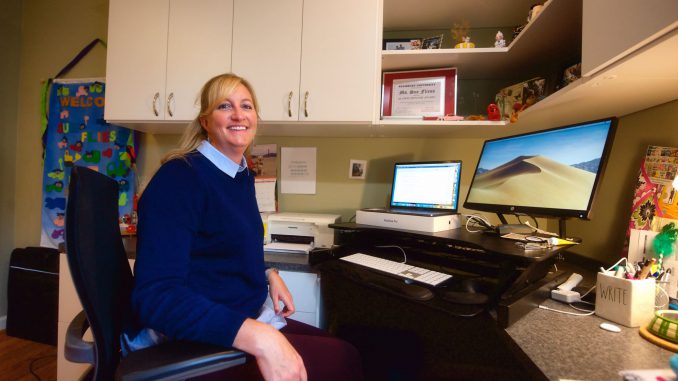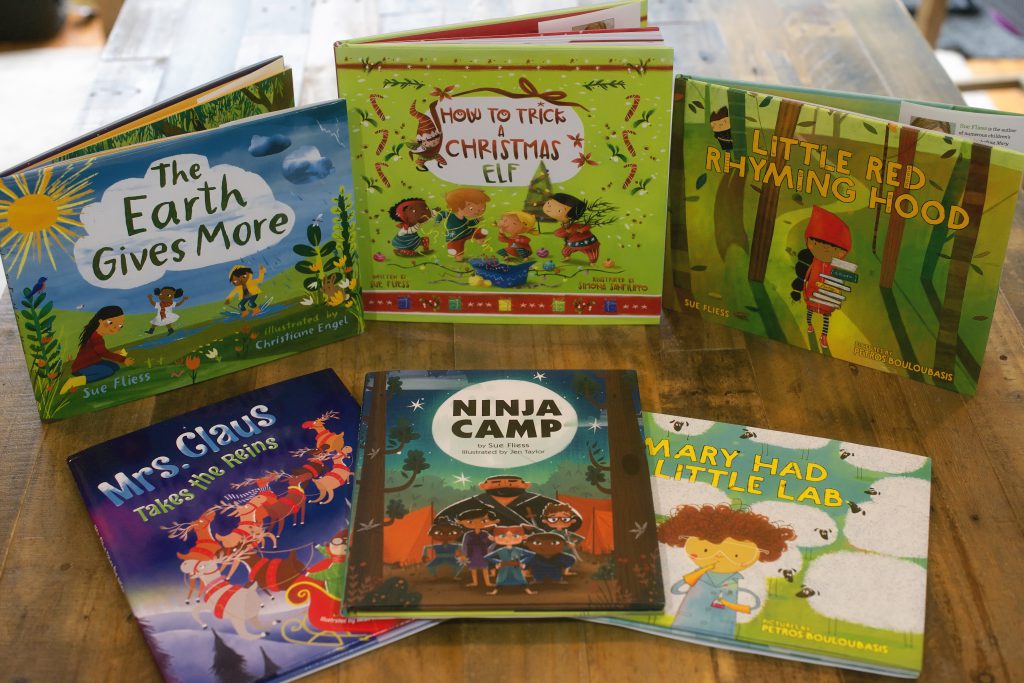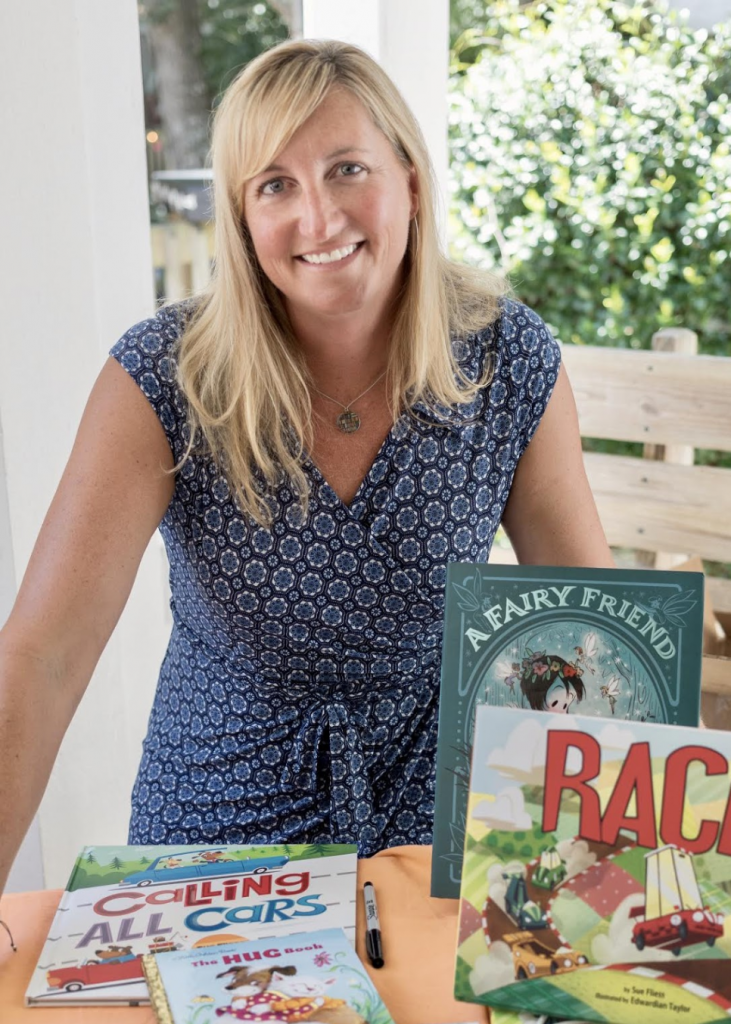
By Chris Wadsworth
It’s the rare author who has even one book published. So, what to make of an author who has dozens of books published and another dozen or more in the works? Such is the life of Ashburn resident Sue Fliess — an amazingly creative children’s book writer who is in demand by many of the country’s leading publishers.
Her start was simply a stray thought, an itch to scratch — an itch probably shared by millions of moms and dads — that maybe she could write a book like the ones she had been reading to her child.
“My son was about 2,” Fliess recalled. “I started writing him a story — just to see if I could write a story for kids. I got some encouragement from a neighbor across the street who was a children’s librarian.”
Fliess kept writing, finishing several manuscripts and sending them to publishers while simultaneously searching for an agent. Several fruitless years passed, but she kept trying, attending writers’ conferences, making contacts, following leads.
And then lightning struck. A publisher in upstate New York signed Fliess to a book deal for “Shoes for Me.” That became her first published book, released in 2011.
“Since then, things have taken off,” she said.
Have they ever.
In her eight years as a published author, more than 30 of her manuscripts have been turned into books. Another eight are done and in the publishing process. She’s under contract for five future books and continues to work on several personal projects she hasn’t tried to sell yet. On top of that, one of her current titles and another book series she hasn’t published are being considered for animated television series.

Around the same time Fliess’ first book was making its way to bookstores, literary agent Jennifer Unter opened an agency in New York City. One of the first new writers she brought on as a client was Sue Fliess.
“She has a great voice for children,” Unter said. “A lot of people try and write picture books for children and their voice is an adult voice.”
She believes there are several keys to Fliess’ rapid climb up the children’s book ladder: She has great ideas, she’s a really good writer and she’s easy to work with — which means editors at publishing houses want to work with her again and again.
“She takes her profession seriously,” Unter said. “She’s definitely prolific and she definitely capitalizes on her success. If one book does well, she’ll come up with a bunch of new ideas to pitch to that same editor.”
Writing wasn’t completely new to Fliess. She wrote poetry for her family when she was a little girl growing up in New Jersey. In her 20s, she joined a writing group in New York City where other members gently suggested she drop the poetry (Fliess says it was “dreadful”) and pursue her gift for storytelling by writing a novel for adults. It was while working on that novel — still unfinished nearly 25 years later — that she was inspired to write a children’s book.
The rest is history.
Today, Fliess, 46, lives in Ashburn’s Timberbrooke Estates neighborhood with her husband, Kevin, and her teenage sons, Owen and Wyatt. She writes pretty much full time — and she needs to with all the projects she’s juggling.
Her latest book fits in nicely with the holiday season. It’s called “How to Trick a Christmas Elf” and was released by Sky Pony Press this fall.
“I brainstormed a lot on this one. I didn’t want it to come off that you could trick someone into getting what you want for Christmas,” Fliess said. “The [children in the book] know that the elf is taking notes on them and will put them on either the naughty list or the nice list. So, they make him a miniature sleigh to distract him so they can peek at the list. But the elf is so happy with the sleigh — it’s the first time ever that he has received a gift himself — that he puts all of them on the nice list. Everyone wins.”
In that storyline may lie the secret of Fliess’ success. Her stories and her characters are not easy, mindless rhymes. Rather they are surprisingly complex and sophisticated.
“You can’t just write simple, little stories. They want multiple layers and multiple hooks now,” she said.
Take “Mary Had a Little Lab,” her spin on the famous nursery rhyme. In the story, Mary doesn’t have any friends, so she decides to get a pet — a sheep, to be exact. So, she invents a machine — the Sheepinator — to make her a furry friend. Soon, all her classmates want sheep, too. Things go haywire, and Mary has to find a solution. The subtle message that Mary is a little girl who likes science and engineering should not be lost on anyone.
“The story and the humor have to work on several levels with different levels of complexity for it to be a crowd pleaser,” said Jennifer Roy, head of children’s services at the Brambleton Library. Roy has seen first-hand how much kids love Fliess’ books during the many read-alouds the author has done at local libraries and schools.
“She has an uncanny way of picking out the things that really speak to kids, things that are really, really popular,” Roy said. “She wrote one about ninjas — kids can’t get enough of ninjas — one about fairies, one about cars. These are things that kids are already passionate and excited about.”
Nowadays, Fliess finds those story ideas everywhere. During a recent walk through an airport, she saw an advertising poster that featured a goat. It prompted a possible idea for a book, and she quickly sent herself an email with some thoughts. (She won’t share details of the goat story just in case it turns into a future book deal.)
“I’ve trained my brain to spot ideas almost to fault,” she said. “Sometimes, I’m like, ‘Turn it off, Sue. Go for a walk. Pay attention to your dog.’” With Fliess’ luck, going for a walk and playing with her dog would probably result in two more book ideas.

Fliess has no plans to slow down her writing pace. She continues to strike deals with publishers, and some of her titles have begat a series of similarly themed books. “How to Trick a Christmas Elf” is actually a follow up to “How to Trap a Leprechaun” and “How to Track an Easter Bunny.” “How to Find a Unicorn” is scheduled for publication in the spring.
Meanwhile, Fliess says she would love to write a longer novel — one aimed at middle-schoolers or maybe the huge YA market (young adult) — and she sometimes daydreams about trying her hand at a screenplay.
“I feel like I have a lot of teen angst still left in me,” Fliess said with a laugh. “I even have some ideas for horror stories, believe it or not.”
Oh my! What would the elves and unicorns say about that?
=====
5 QUESTIONS WITH SUE FLIESS
WHERE DID YOU GO TO COLLEGE AND WHAT DID YOU STUDY?
“I went to Salisbury University in Salisbury, Md., on the Eastern Shore. I majored in communications arts and minored in fine arts. I wanted to be an artist, an illustrator. My favorite thing to do was drawing with a pencil on paper, or painting. But then everything started moving toward digital and it seemed scary and foreign to me. Maybe if I had stuck with it, I’d be working for Pixar now.”
WHAT DID YOU DO BEFORE YOU BECAME A WRITER?
“My first job was as a publicist for a big publishing house. It gave me an appreciation of everything that goes into a book once it is published. And dealing with authors helped me avoid being a nightmare author myself.”
WHAT DO YOUR KIDS THINK OF YOUR BOOKS?
“I think they’re impressed. When they were younger, they liked to say, ‘Our mom is an author,’ but now they just say their mom writes children’s books. But I think they’re proud of me. I think they think it’s cool.”
WHAT WAS YOUR MOST CHALLENGING BOOK TO WRITE?
“My book ‘Little Red Rhyming Hood’ is about a little girl who speaks in rhyme. In my first few versions, the entire manuscript was in rhyme. But my critique group pointed out that Little Red’s voice — since her speaking in rhyme is what makes her quirky — was getting lost. So I took all but Red’s dialogue out of rhyme. At some point, she and Big Brad Wolf speak in rhyme together — in alternating lines, so then I had to rhyme two characters’ dialogues — half in rhyme, half in prose. This was one of the most challenging books I’ve ever written.”
WHO DOES THE ILLUSTRATIONS IN YOUR BOOKS?
“Once they buy my manuscript, the publisher goes to their art director and chooses the illustrator that they think will best match the story. I have very little say … but I feel like I have been very lucky and very fortunate with all the illustrators that I have worked with.”
(Image at top: Alex Erkiletian Photography)

